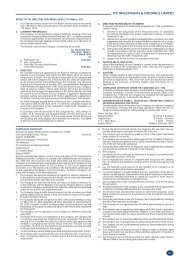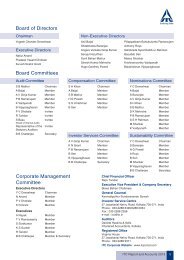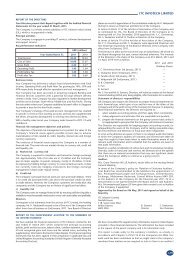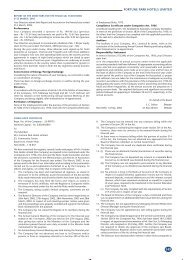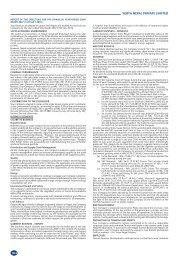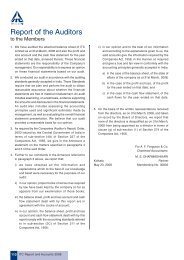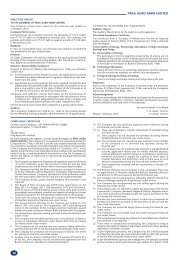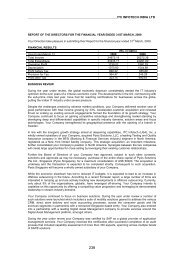TECHNICO AGRI SCIENCES LIMITED - ITC i
TECHNICO AGRI SCIENCES LIMITED - ITC i
TECHNICO AGRI SCIENCES LIMITED - ITC i
You also want an ePaper? Increase the reach of your titles
YUMPU automatically turns print PDFs into web optimized ePapers that Google loves.
<strong>TECHNICO</strong> <strong>AGRI</strong> <strong>SCIENCES</strong> <strong>LIMITED</strong><br />
NOTES TO FINANCIAL STATEMENTS FOR THE YEAR ENDED 31ST MARCH 2013<br />
1 Nature of Operations<br />
The Company is in the business of producing and selling TECHNITUBER® Seed<br />
Potatoes and Field Generated Seed Potatoes. The Company's production<br />
process comprises TECHNITUBER® Seed Potatoes (i.e. G-0) and Field Generated<br />
Seed Potatoes which can itself have several stages like G-1, G-2 and so on.<br />
During the G-0 stage, the TECHNITUBER® Seed Potatoes are produced under<br />
a controlled environment in the nurseries maintained at the facility situated<br />
at Village Manpura, District Solan, Himachal Pradesh. The TECHNITUBER®<br />
Seed Potatoes produced in the G-0 stage are taken for field plantation for<br />
further production of next stage i.e. G-1, which is again taken for subsequent<br />
production for another generation and so on depending on the production<br />
and sales strategy. The Company also supplies bought out Agri Inputs comprising<br />
Insecticides, Fungicides and Micronutrients to the farmers associated with the<br />
Company for growing Field Generated Seed Potatoes. The trial production of<br />
Tissue Culture Plantlets of Banana continues in the facility situated at Village<br />
Manpura, District Solan, Himachal Pradesh.<br />
2 Basis of Preparation<br />
The financial statements have been prepared to comply in all material respects<br />
with the notified accounting standards by the Companies Accounting Standards<br />
Rules, 2006 (as amended) and the relevant provisions of the Companies Act,<br />
1956. The financial statements have been prepared under the historical cost<br />
convention on an accrual basis. The accounting policies have been consistently<br />
applied by the Company and are consistent with those used in the previous<br />
year.<br />
2.1 Statement of Significant Accounting Policies<br />
a) Use of Estimates<br />
The preparation of financial statements in conformity with generally accepted<br />
accounting principles requires management to make estimates and assumptions<br />
that affect the reported amounts of assets and liabilities and disclosure of<br />
contingent liabilities at the date of the financial statements and the results of<br />
operations during the reporting period end. Although these estimates are<br />
based upon management's best knowledge of current events and actions,<br />
actual results could differ from these estimates.<br />
b) Fixed Assets<br />
Fixed Assets are stated at historical cost less accumulated depreciation and<br />
impairment losses, if any. Cost comprises the purchase price and any attributable<br />
cost of bringing the asset to its working condition for its intended use.<br />
c) Depreciation<br />
Depreciation on Fixed Assets, except for Leasehold Improvements and part<br />
of Plant and Machinery used in field operations, is provided on straight-line<br />
method at the rates prescribed in Schedule XIV to the Companies Act, 1956<br />
which are not lower than rates based on estimated useful lives of the respective<br />
assets. Leasehold Improvements are depreciated over the period of Primary<br />
lease and part of Plant and Machinery used in field operations is depreciated<br />
over five to eight years which is determined based on technical evaluation.<br />
Assets Rates (SLM) Rates Schedule XIV<br />
Buildings 1.63% - 3.34% 1.63% - 3.34%<br />
Plant and Equipment 4.75% - 20% 4.75%<br />
Office Equipment 4.75% 4.75%<br />
Furniture and Fixtures 6.33% 6.33%<br />
Vehicles 9.5% 9.5%<br />
Computers,Servers and<br />
other IT equipments 16.21% 16.21%<br />
Licenced Properties- Over the Primary<br />
Building Improvements Lease Period —<br />
All assets costing `.5,000 or below are fully depreciated in the year of<br />
addition.<br />
d) Impairment of Assets<br />
(i) The carrying amounts of assets are reviewed at each balance sheet date,<br />
if there is any indication of impairment based on internal/external factors.<br />
An impairment loss is recognized wherever the carrying amount of an<br />
asset exceeds its recoverable amount. The recoverable amount is the<br />
greater of the assets net selling price and value in use. In assessing value<br />
in use, the estimated future cash flows are discounted to their present<br />
value at the weighted average cost of capital.<br />
(ii) After impairment, depreciation is provided on the revised carrying amount<br />
of the asset over its remaining useful life.<br />
e) Inventories<br />
Inventories are valued as follows:<br />
(i) Stores & Spares<br />
At cost or net realizable value, whichever is lower, arrived at on FIFO basis<br />
(ii) TECHNITUBER® Seed Potatoes, Field Generated Seed Potatoes and<br />
Banana Tissue Culture Plantlets<br />
At cost or net realizable value whichever is lower. Cost for this purpose<br />
includes all direct costs incurred up to the stage of production of the<br />
respective inventories. Borrowing costs relating to generation of<br />
TECHNITUBER® Seed Potatoes, Field Generated Seed Potatoes and Banana<br />
Tissue Culture Plantlets which takes substantial period of time to get ready<br />
for sale are also included to the extent they relate to the period till such<br />
stocks are ready for sale. Cost is determined on FIFO basis for TECHNITUBER®<br />
Seed Potatoes and Banana Tissue Culture Plantlets and weighted average<br />
basis for Field Generated Seed Potatoes.<br />
Net realizable value is the estimated selling price in the ordinary course of<br />
business, less estimated costs of completion and estimated costs necessary<br />
to make the sale.<br />
(iii) Insecticides, Fungicides and Micronutrients<br />
At cost or net realizable value, whichever is lower, arrived at on FIFO basis.<br />
f) Foreign Currency Transactions<br />
(i) Initial Recognition<br />
Foreign currency transactions are recorded in the reporting currency, by<br />
applying to the foreign currency amount, the exchange rate between the<br />
reporting currency and the foreign currency at the date of the transaction.<br />
(ii) Conversion<br />
Foreign currency monetary items are reported using the closing rate. Nonmonetary<br />
items which are carried in terms of historical cost denominated<br />
in a foreign currency, are reported using the exchange rate at the date of<br />
the transaction and non-monetary items which are carried at fair value or<br />
other similar valuation denominated in a foreign currency, are reported<br />
using the exchange rates that existed when the values were determined.<br />
(iii) Exchange Differences<br />
Exchange differences arising on the settlement of monetary items or on<br />
reporting monetary items of the Company, at rates different from those<br />
at which they were initially recorded during the year, or reported in previous<br />
financial statements are recognised as income or as expenses in the year<br />
in which they arise except those arising from investments in non-integral<br />
operations.<br />
g) Investment<br />
Investments that are readily realisable and intended to be held for not more<br />
than a year are classified as current investments. All other investments are<br />
classified as long-term investments. Current investments are carried at lower<br />
of cost and fair value, determined on an individual investment basis. Long-term<br />
investments are carried at cost. However, provision for diminution in value is<br />
made to recognise a decline other than temporary in the value of the investments.<br />
h) Borrowing Cost<br />
Borrowing costs consist of interest and other costs that an entity incurs in<br />
connection with the borrowing of funds. Borrowing costs directly attributable<br />
to the acquisition, construction or production of an asset that necessarily takes<br />
a substantial period of time to get ready for its intended use or sale are capitalized<br />
as part of the cost of the respective asset. All other borrowing costs are expensed<br />
in the period they occur.<br />
i) Revenue Recognition<br />
Revenue is recognized to the extent that it is probable that the economic<br />
benefits will flow to the Company and the revenue can be reliably measured.<br />
(i) Sale of Goods<br />
Revenue from sale of goods is recognized on transfer of risks and rewards,<br />
which coincides with the dispatch of goods to the customers.<br />
(ii) Interest<br />
Revenue from interest (incl. of tax deducted at source) is recognized on<br />
a time proportion basis taking into account the amount outstanding and<br />
the rate applicable.<br />
(iii) Dividend<br />
Revenue from dividend is recognised when the right to receive payment<br />
is established at the balance sheet date.<br />
(iv) Rental Income<br />
Rental income is recognised in the Statement of Profit and Loss as per lease<br />
terms.<br />
j) Retirement Benefits<br />
(i) Retirement benefits in the form of Provident Fund are a defined contribution<br />
scheme and the contributions are charged to the Statement of Profit and<br />
Loss of the year, when the contributions to the respective funds are due.<br />
There are no other obligations other than the contribution payable to the<br />
respective funds.<br />
(ii) Gratuity liability is a defined benefit obligation and is provided for on the<br />
basis of an actuarial valuation on projected unit credit method made at<br />
the end of each financial year.<br />
78




